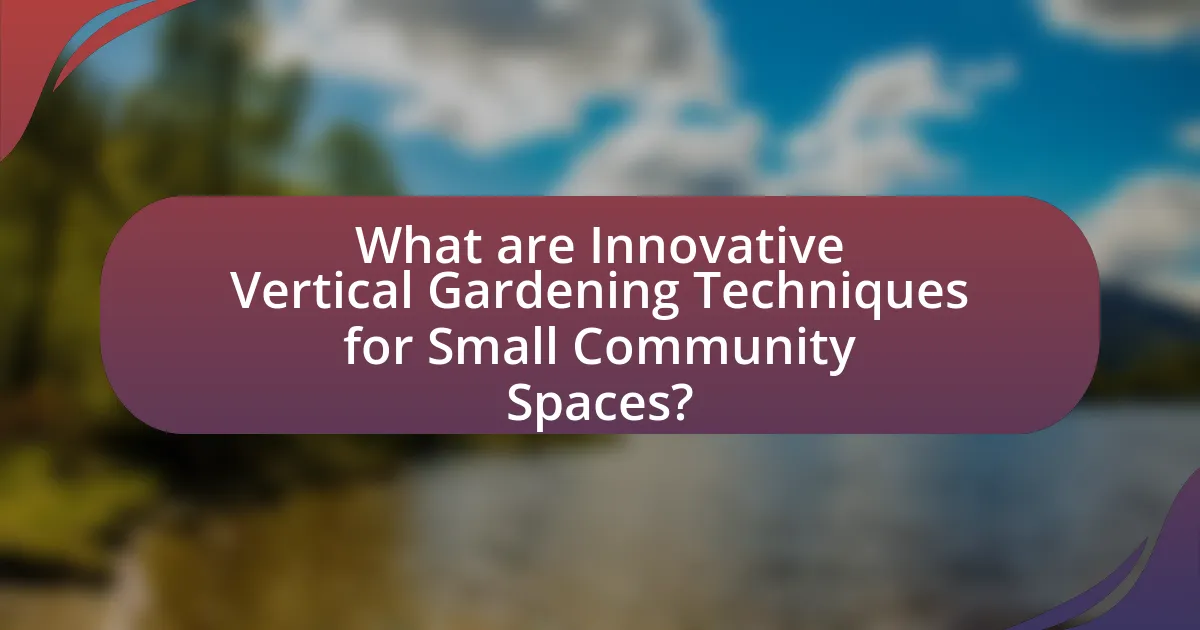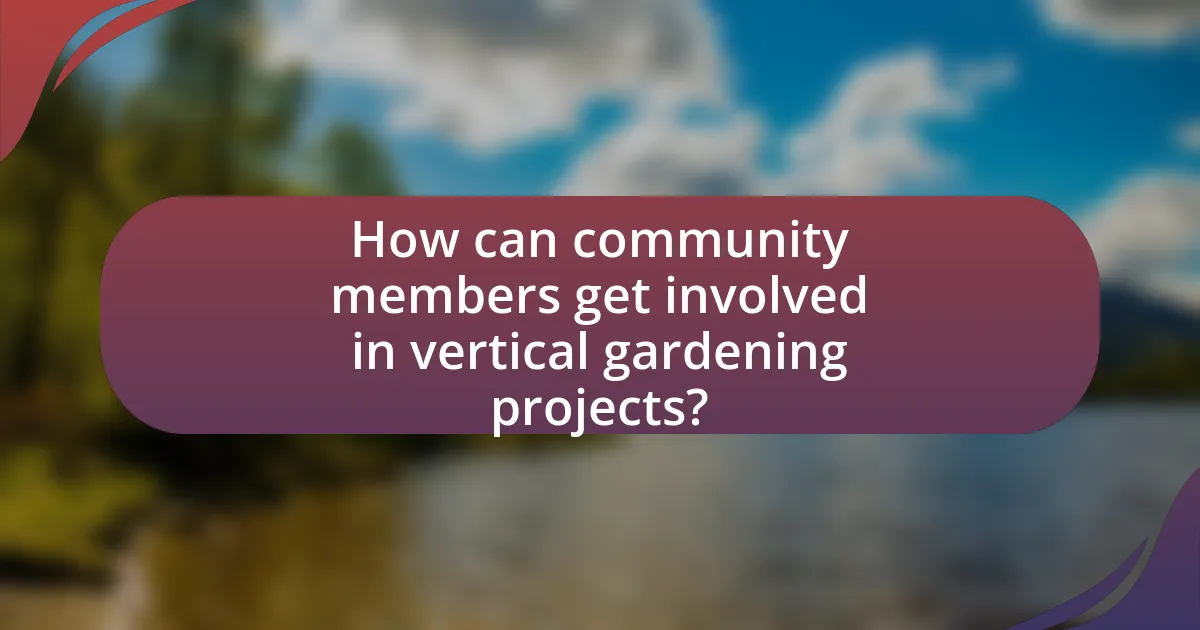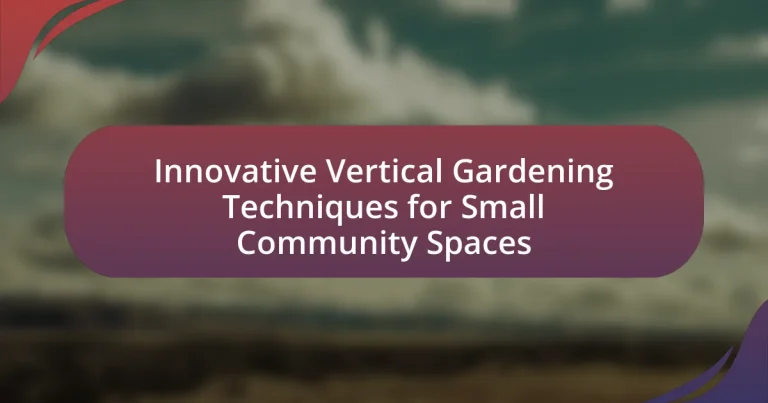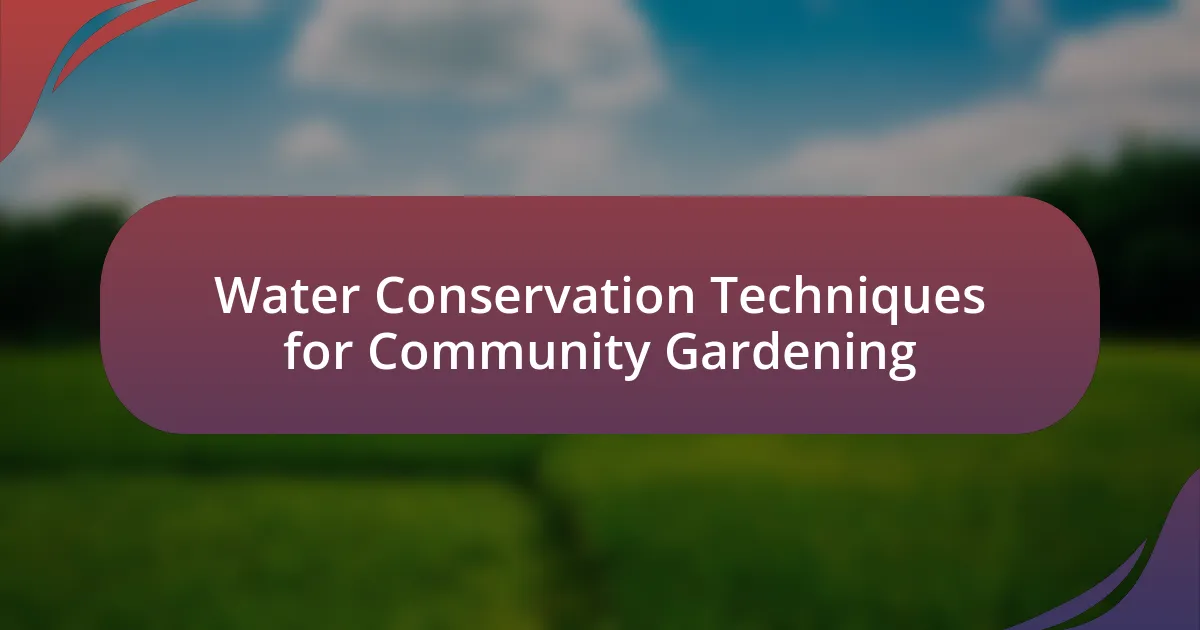Innovative vertical gardening techniques are transforming small community spaces by utilizing methods such as modular planting systems, hydroponic towers, and living walls. These approaches maximize space efficiency, enhance biodiversity, and improve air quality while promoting community engagement. The article explores how vertical gardening differs from traditional methods, the principles behind its success, and the benefits it offers, including increased crop yields and social cohesion. Additionally, it addresses practical considerations such as plant selection, irrigation systems, and the use of recycled materials, providing a comprehensive overview of how communities can effectively implement vertical gardening initiatives.

What are Innovative Vertical Gardening Techniques for Small Community Spaces?
Innovative vertical gardening techniques for small community spaces include modular planting systems, hydroponic towers, and living walls. Modular planting systems allow for customizable arrangements of plants in limited areas, maximizing space efficiency. Hydroponic towers utilize nutrient-rich water to grow plants vertically, reducing the need for soil and increasing yield in confined spaces. Living walls, or green walls, integrate vegetation into building exteriors or interiors, improving air quality and aesthetics while utilizing vertical surfaces. These techniques have been shown to enhance biodiversity and promote community engagement in urban environments.
How do these techniques differ from traditional gardening methods?
Innovative vertical gardening techniques differ from traditional gardening methods primarily in their use of vertical space to maximize plant growth in limited areas. Traditional gardening typically involves horizontal planting in soil beds, which requires more ground space and often leads to lower plant density. In contrast, vertical gardening utilizes structures such as trellises, wall planters, and stacked systems, allowing for increased plant variety and density in smaller community spaces. This method not only conserves land but also enhances air circulation and sunlight exposure for plants, leading to potentially higher yields. Studies have shown that vertical gardens can increase crop production by up to 30% compared to traditional methods, making them a more efficient option for urban environments.
What are the key principles behind vertical gardening?
The key principles behind vertical gardening include maximizing space, ensuring proper plant selection, and implementing effective irrigation and support systems. Maximizing space allows for the cultivation of plants in limited areas, making vertical gardening ideal for small community spaces. Proper plant selection involves choosing species that thrive in vertical environments, such as herbs, succulents, and climbing plants, which can adapt to varying light and moisture conditions. Effective irrigation systems, such as drip irrigation or self-watering mechanisms, ensure that plants receive adequate moisture without over-saturation, promoting healthy growth. These principles collectively enhance the efficiency and sustainability of vertical gardens, making them a viable solution for urban gardening challenges.
How do vertical gardens maximize space in small areas?
Vertical gardens maximize space in small areas by utilizing vertical surfaces for plant growth, thereby reducing the need for horizontal ground space. This technique allows for the cultivation of a larger number of plants in a confined area, effectively increasing greenery without expanding the footprint. For instance, a vertical garden can yield the same amount of produce as a traditional garden while occupying significantly less ground area, making it ideal for urban environments where space is limited. Additionally, vertical gardens can improve air quality and provide insulation, further enhancing the utility of small spaces.
What are the benefits of implementing vertical gardening in community spaces?
Implementing vertical gardening in community spaces offers numerous benefits, including enhanced aesthetics, improved air quality, and increased biodiversity. Vertical gardens can transform underutilized areas into vibrant green spaces, which can boost community morale and engagement. Studies show that plants in urban environments can reduce air pollutants by up to 30%, contributing to healthier living conditions. Additionally, vertical gardens provide habitats for various species, promoting biodiversity in urban settings. These gardens also optimize space usage, allowing communities to grow food in limited areas, which can improve food security and foster community cooperation.
How does vertical gardening contribute to urban greening?
Vertical gardening significantly contributes to urban greening by maximizing limited space for plant growth, thereby enhancing biodiversity and improving air quality. This method allows for the cultivation of plants on walls and other vertical surfaces, which can lead to increased vegetation in densely populated areas. Studies indicate that vertical gardens can reduce urban heat islands, lower energy consumption for cooling, and capture carbon dioxide, thus mitigating climate change effects. For instance, a study published in the journal “Urban Forestry & Urban Greening” found that vertical gardens can reduce ambient temperatures by up to 5 degrees Celsius, demonstrating their effectiveness in urban environments.
What social benefits can arise from community vertical gardens?
Community vertical gardens can foster social cohesion and enhance community engagement. These gardens create shared spaces where individuals collaborate, leading to stronger relationships among neighbors. Research indicates that community gardening initiatives can reduce crime rates by promoting social interaction and a sense of ownership in the area. Additionally, vertical gardens can improve mental well-being by providing therapeutic environments, as studies show that green spaces contribute to reduced stress and increased happiness. Furthermore, they can serve as educational platforms, teaching participants about sustainable practices and nutrition, thereby empowering communities with knowledge and skills.

What materials and structures are commonly used in vertical gardening?
Common materials and structures used in vertical gardening include trellises, wall planters, and modular planting systems. Trellises, often made from wood or metal, provide support for climbing plants, while wall planters, which can be constructed from plastic, wood, or metal, allow for the attachment of pots or planting pockets directly to walls. Modular planting systems, typically made from lightweight materials like fabric or plastic, enable easy assembly and customization for various spaces. These materials and structures facilitate efficient use of vertical space, making them ideal for small community gardens.
How can recycled materials be utilized in vertical gardens?
Recycled materials can be utilized in vertical gardens by repurposing items such as plastic bottles, wooden pallets, and old tires to create planting structures. For instance, plastic bottles can be cut and hung to form vertical planters, allowing for efficient use of space and resources. Wooden pallets can be transformed into vertical frames that support soil and plants, promoting sustainable gardening practices. Additionally, old tires can be stacked or arranged to create unique planting beds, enhancing both aesthetics and functionality. These methods not only reduce waste but also contribute to the sustainability of urban gardening initiatives, as evidenced by community projects that have successfully implemented such techniques to maximize limited space while promoting environmental responsibility.
What types of containers are best for vertical gardening?
The best types of containers for vertical gardening include wall planters, hanging pots, and vertical garden systems. Wall planters are designed to attach directly to walls, maximizing space and allowing for a variety of plants to thrive in a compact area. Hanging pots can be suspended from hooks or brackets, providing an attractive way to display plants while saving ground space. Vertical garden systems, often modular, allow for multiple layers of planting, which can accommodate a diverse range of herbs, flowers, and vegetables. These container types are effective because they utilize vertical space efficiently, which is crucial in small community spaces where ground area is limited.
How do different structures affect plant growth in vertical gardens?
Different structures in vertical gardens significantly influence plant growth by affecting light exposure, water retention, and nutrient availability. For instance, trellis systems allow climbing plants to access more sunlight, which enhances photosynthesis and growth rates. Additionally, modular systems with integrated irrigation can optimize water distribution, ensuring that plants receive adequate moisture without waterlogging. Research indicates that vertical gardens with varied structural designs can increase plant diversity and yield; a study published in the Journal of Urban Agriculture found that plants grown on vertical grids exhibited a 30% increase in growth compared to those in traditional horizontal beds. Thus, the choice of structure directly impacts the overall health and productivity of plants in vertical gardening.
What plants are best suited for vertical gardening in small spaces?
The best plants suited for vertical gardening in small spaces include herbs like basil and mint, leafy greens such as lettuce and spinach, and compact flowering plants like petunias and nasturtiums. These plants thrive in limited space due to their growth habits and relatively small size. For instance, herbs can be grown in small containers or pockets, while leafy greens have shallow root systems that adapt well to vertical setups. Additionally, flowering plants like petunias can cascade down, adding aesthetic appeal without requiring extensive horizontal space.
Which herbs thrive in vertical gardens?
Herbs that thrive in vertical gardens include basil, mint, parsley, chives, and oregano. These herbs are well-suited for vertical gardening due to their compact growth habits and ability to adapt to limited soil space. For instance, basil grows well in smaller containers and benefits from the increased air circulation in vertical setups, while mint’s vigorous growth can be easily managed in a vertical arrangement. Studies have shown that herbs like these can flourish in vertical gardens, providing both aesthetic appeal and culinary benefits in small community spaces.
What flowering plants can enhance the aesthetic of vertical gardens?
Flowering plants that can enhance the aesthetic of vertical gardens include petunias, begonias, and fuchsias. Petunias offer vibrant colors and a cascading growth habit, making them ideal for vertical arrangements. Begonias provide lush foliage and colorful blooms, thriving in various light conditions, which adds depth to vertical gardens. Fuchsias, known for their unique, pendulous flowers, create visual interest and attract pollinators. These plants not only beautify vertical gardens but also contribute to biodiversity, supporting local ecosystems.

How can community members get involved in vertical gardening projects?
Community members can get involved in vertical gardening projects by participating in local workshops and volunteer days organized by community gardens or environmental organizations. These events often provide hands-on experience in building and maintaining vertical gardens, fostering skills in gardening techniques and sustainable practices. Additionally, community members can contribute by donating materials such as planters, soil, or plants, which are essential for establishing vertical gardens. Engaging in social media groups or local forums dedicated to gardening can also facilitate collaboration and sharing of resources among members interested in vertical gardening initiatives.
What steps should be taken to start a vertical gardening initiative?
To start a vertical gardening initiative, first, assess the available space and light conditions to determine suitable plants. Next, select a vertical gardening system, such as wall planters, trellises, or modular systems, that fits the chosen location. After that, gather necessary materials, including soil, plants, and irrigation tools, to ensure proper growth. Finally, implement a maintenance plan that includes regular watering, pruning, and monitoring for pests to sustain the garden’s health. These steps are essential for establishing a successful vertical garden, which can enhance community spaces by promoting greenery and biodiversity.
How can community members collaborate on vertical gardening projects?
Community members can collaborate on vertical gardening projects by forming local gardening groups that share resources, knowledge, and labor. These groups can organize workshops to teach vertical gardening techniques, such as using recycled materials for planters or implementing hydroponic systems. Collaboration can also involve pooling funds for purchasing materials and plants, thereby reducing individual costs. Additionally, community members can establish a shared garden space where they can collectively design and maintain vertical gardens, fostering a sense of community and shared responsibility. This approach not only enhances the gardening experience but also promotes sustainability and environmental awareness within the community.
What resources are available for community vertical gardening education?
Community vertical gardening education resources include online platforms, local workshops, and community gardening organizations. Websites like the American Community Gardening Association provide guides and resources tailored to vertical gardening techniques. Local universities often host workshops that focus on sustainable gardening practices, including vertical gardening. Additionally, community gardening organizations frequently offer hands-on training sessions and educational materials to help residents implement vertical gardens effectively. These resources are essential for promoting knowledge and skills in vertical gardening within communities.
What are some best practices for maintaining vertical gardens?
To maintain vertical gardens effectively, regular watering, appropriate plant selection, and consistent pruning are essential practices. Regular watering ensures that plants receive adequate moisture, which is crucial for their growth; using a drip irrigation system can optimize water usage. Selecting plants that thrive in vertical environments, such as trailing vines and compact shrubs, enhances the garden’s aesthetic and health. Consistent pruning helps manage growth and encourages new blooms, preventing overcrowding and promoting air circulation. These practices are supported by studies indicating that proper maintenance significantly increases plant health and longevity in vertical gardens.
How often should vertical gardens be watered and fertilized?
Vertical gardens should be watered at least once a day, especially in hot weather, while fertilization should occur every 4 to 6 weeks. Regular watering ensures that the plants receive adequate moisture, which is crucial for their growth and health. Fertilizing every 4 to 6 weeks provides essential nutrients that support plant development and vitality. This frequency is supported by horticultural practices that emphasize the importance of consistent moisture and nutrient availability for vertical garden success.
What common pests and diseases should be monitored in vertical gardens?
Common pests that should be monitored in vertical gardens include aphids, spider mites, and whiteflies, while diseases such as powdery mildew and root rot are also significant concerns. Aphids can rapidly reproduce and damage plants by sucking sap, leading to stunted growth. Spider mites thrive in dry conditions and can cause leaf discoloration and webbing. Whiteflies, similar to aphids, feed on plant sap and can transmit viruses. Powdery mildew is a fungal disease that appears as white powder on leaves, often thriving in humid conditions, while root rot, caused by overwatering or poor drainage, can lead to plant death. Monitoring these pests and diseases is crucial for maintaining plant health and ensuring the success of vertical gardens.
What challenges might arise in vertical gardening for small community spaces?
Challenges in vertical gardening for small community spaces include limited sunlight exposure, inadequate structural support, and water management issues. Limited sunlight can hinder plant growth, as many vertical gardens may be positioned in shaded areas or face obstructions. Inadequate structural support can lead to instability, risking damage to plants and the garden structure itself. Water management issues arise from the need for efficient irrigation systems, as vertical gardens often require more frequent watering and careful drainage to prevent over-saturation. These challenges can significantly impact the success and sustainability of vertical gardening initiatives in small community spaces.
How can limited sunlight affect vertical gardening success?
Limited sunlight can significantly hinder vertical gardening success by restricting plant growth and reducing yield. Plants require adequate sunlight for photosynthesis, which is essential for their development and productivity. In vertical gardens, insufficient light can lead to weak, leggy plants that struggle to thrive, resulting in lower harvests. Research indicates that many vegetables and herbs need at least six hours of direct sunlight daily to grow optimally. Without this, plants may exhibit stunted growth, poor flowering, and diminished fruit production, ultimately compromising the effectiveness of vertical gardening in small community spaces.
What strategies can be employed to overcome space limitations?
To overcome space limitations in small community spaces, implementing vertical gardening techniques is essential. Vertical gardening utilizes structures such as trellises, wall planters, and vertical frames to maximize planting area while minimizing ground space usage. For instance, a study by the University of California Cooperative Extension indicates that vertical gardens can increase plant yield by up to 30% compared to traditional gardening methods, demonstrating their effectiveness in optimizing limited space. Additionally, using modular planting systems allows for flexibility and adaptability in various environments, further enhancing the ability to utilize small areas efficiently.
What practical tips can enhance the success of vertical gardening in community spaces?
To enhance the success of vertical gardening in community spaces, implement proper plant selection, utilize efficient irrigation systems, and ensure adequate structural support. Selecting plants that thrive in vertical environments, such as herbs, leafy greens, and flowering plants, increases the likelihood of a productive garden. Efficient irrigation systems, like drip irrigation, conserve water and deliver moisture directly to the roots, promoting healthy growth. Additionally, using sturdy materials for vertical structures, such as trellises or wall-mounted planters, ensures that plants remain secure and can grow effectively. These strategies are supported by studies indicating that appropriate plant choices and irrigation methods significantly improve yield and sustainability in community gardening initiatives.





